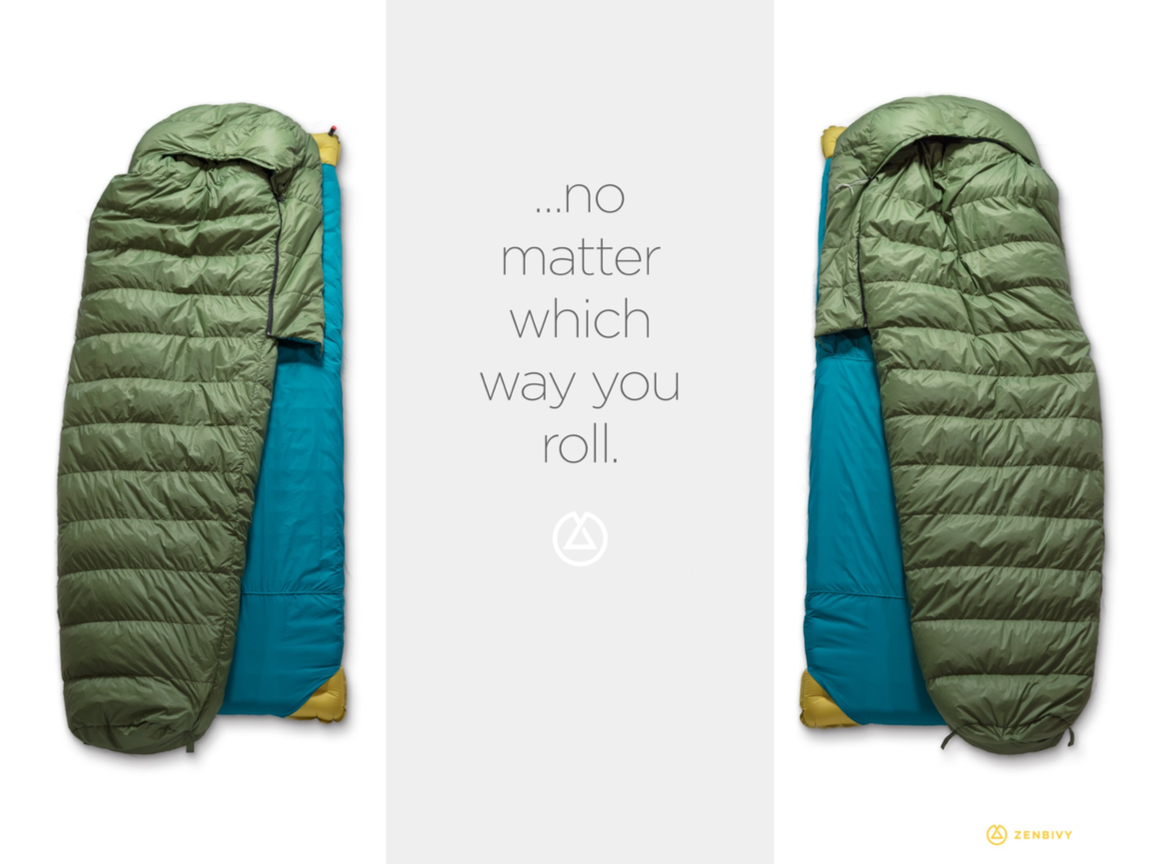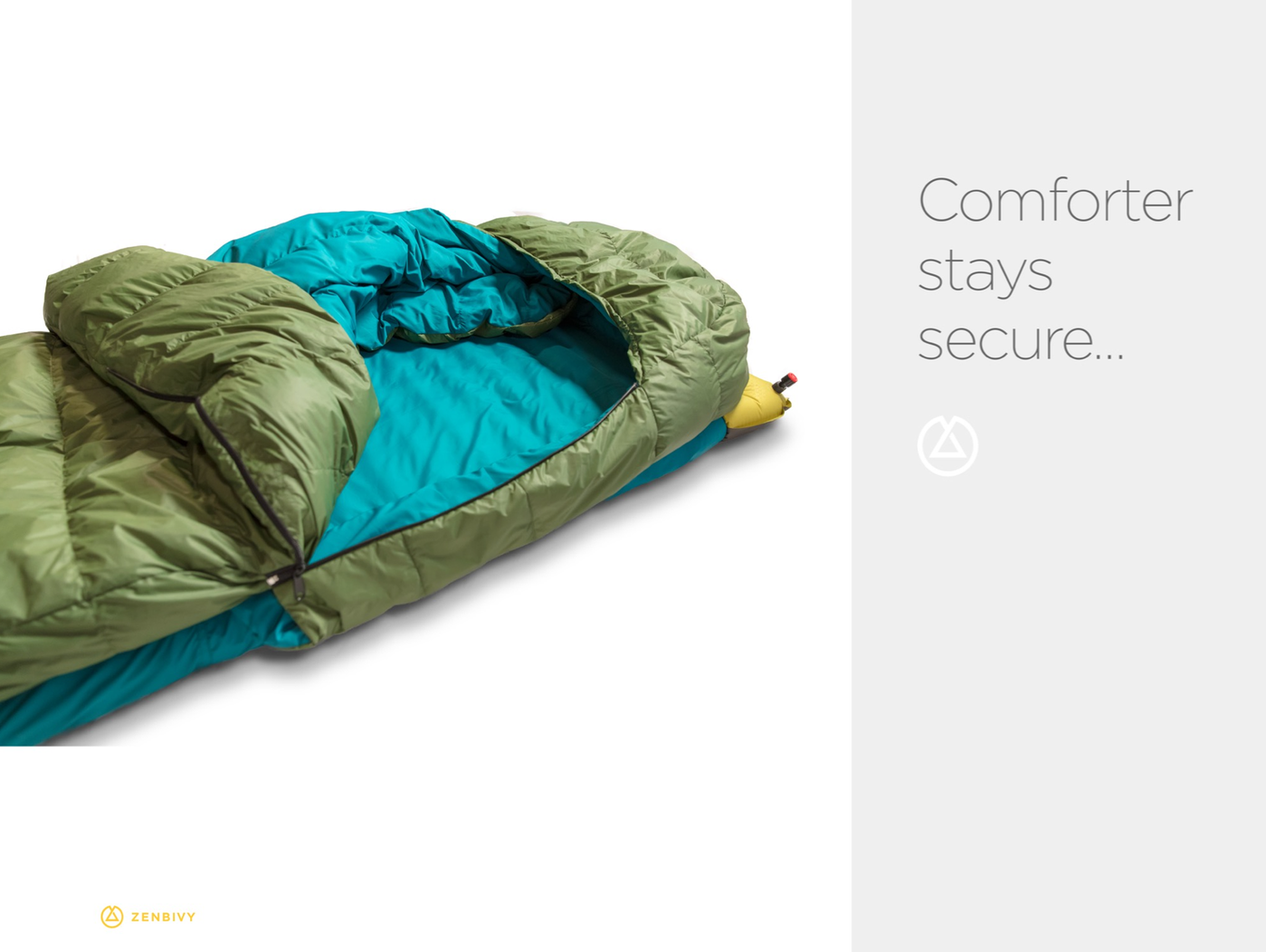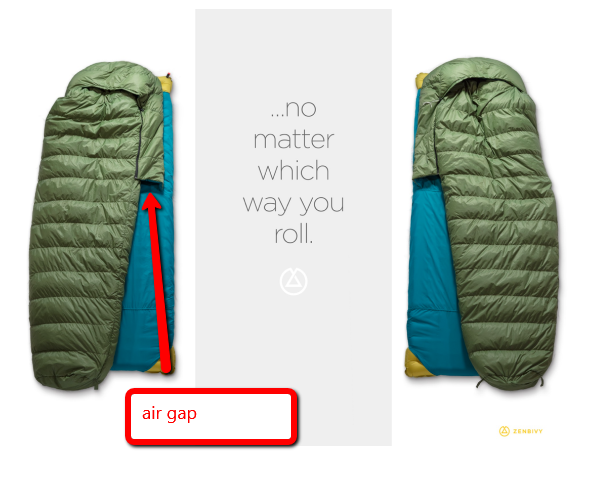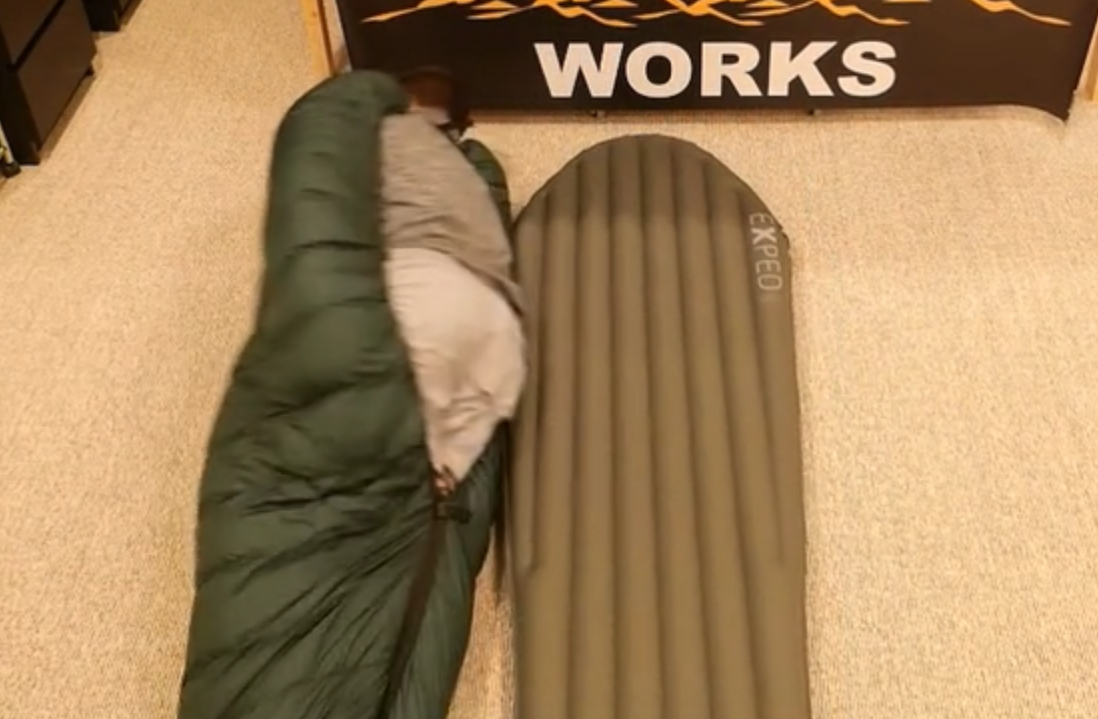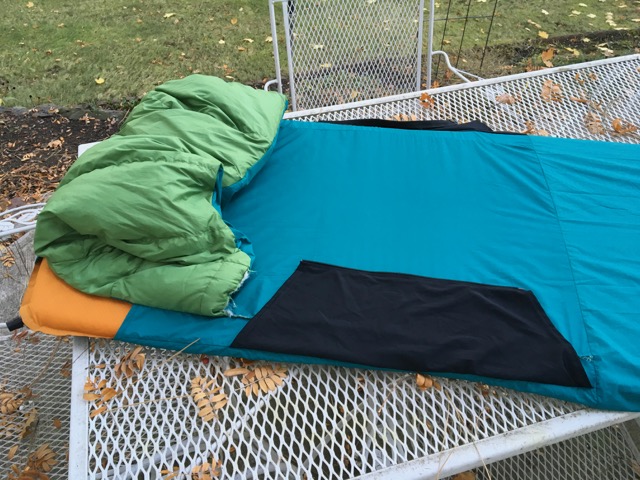Topic
NEW quilt / pad interface from ZENBIVY
Forum Posting
A Membership is required to post in the forums. Login or become a member to post in the member forums!
Home › Forums › Gear Forums › Gear (General) › NEW quilt / pad interface from ZENBIVY
- This topic has 47 replies, 15 voices, and was last updated 6 years, 4 months ago by
 Michael Glavin / Zenbivy.
Michael Glavin / Zenbivy.
-
AuthorPosts
-
Feb 24, 2017 at 11:21 am #3452595
Richie:
I’m a “flipper” too. The big advantage to me of this system is that I don’t need to think about flipping anymore, or hold on to the bag to keep it around me. You just sleep normally. And unlike all the strap systems described above and in associated links, you are not pinned. All of this is very hard to convey with pictures, but we obviously need to describe that somehow. Working on that….
No doubt our biggest challenge out of the gate is conveying something that is so dramatically new and different. The folks on BPL are already aware of quilts, and tend to think of it from the BPL perspective, which has traditionally been focused on quilt’s weight benefits vs. the comfort benefits. But most people have no idea what a backpacking quilt is, so I’m hoping the first impression will be how much more comfortable this is than a mummy bag. The “simple message” is they key, I agree.
Its funny, I have never shown a new idea at BPL that has been particularly well received (hey, at least I don’t get berated just for being here anymore). I show stuff here because every so often someone identifies a problem or an improvement that we have not thought of; as you said, everyone here is a designer of sorts. It takes careful consideration (and sometimes thick skin) to separate the good ideas from someone’s one-off solution or personal preference. But every bit of insight is always valuable.
Note, for instance, that it has been suggested multiple times in this thread that this concept does not address a real problem, then over half the thread is people explaining how they are trying to solve the exact same problems.
Feb 24, 2017 at 11:39 am #3452597How about the Mid-Atlantic Mountain Works Marcy 20 Quilt shock cord system( watch video) BPL member JEREMY has been using one since 2014 and really likes it, and Philip Werner says in his review
As a side sleeper myself, I can verify that the side cinch works nicely in cold weather, especially when you’re on a sleeping pad in a tent.
Feb 24, 2017 at 12:04 pm #3452609Let us know when you are ready to take it to market. I may well have to give it a go.
Feb 24, 2017 at 1:35 pm #3452643Could there be a lighter iteration of the hood idea? That looks cozy — and I think could be a good thing for folks who like to breath in their bags (detach and it’s easier to dry it out!).
It’s relevant to compare to a bivy here. Quit straps + bivy and I’m super snug! Yes, like this design, the bivy is a lot of extra fabric, that I maybe don’t need…..but the bottom half of it functions as a ground sheet. The top half has given me some leeway on rain.
So if you could make that expanse of fabric fulfill an additional purpose, maybe the weight could make sense.
Feb 24, 2017 at 2:24 pm #3452655Katherine:
Thanks for your question, and the answer is yes. In previous prototypes the hood and the “hinges” along the side (where the zippers are) were actually two seperate things. We only combined them in the final prototype. In this case, the hinges could be attached to the mattress, the top sheet of the quilt eliminated completely, and the hood removable. This would allow all the benefits of “tucking” with very minimal weight, and the hood could be optional, depending on the trip.
Coming from someone who has spent a lot of nights with quilts inside bivy sacks, the hinges provide the same benefit of the bivy: they keep it all “tucked in” and on the pad.
Feb 24, 2017 at 2:34 pm #3452656Richie:
I’ll post something in the gear deals, for sure. To stay totally up to speed, go to zenbivy.com and sign up to the email list.
Thanks for both the input and the consideration!
Feb 24, 2017 at 3:52 pm #3452678And unlike all the strap systems described above and in associated links, you are not pinned.
Still trying to understand what you mean by pinned. Are you saying that since a normal quilt is attached to straps/clips, that I lose lateral movement on top of my pad? Like..you posted this image ->

Ok….so, yeah, your quilt would have lateral movement “freedom”, if that is what you mean by not “pinning”. I guess I’m having a hard time seeing pinning as a problem though since …if I moved more than just a few inches laterally on my 20″ pad…I’m either going to fall off the pad or the quilt “hole” is going to get exposed. Like…in your pic above, the quilt is half off the pad there and would have air coming in from below.
In fact…if pinning is lack of “lateral movement”…then, I want more pinning! I wouldn’t want my quilt to be able to move laterally. In general…I really like the EE/Katabatic attachment systems. The issue for me is that sometimes when I toss and turn the straps rotate around the pad, so the clips aren’t centered anymore. And if they aren’t centered..then its a higher chance of getting a draft.
Anyway, I was also just trying to understand a bit more about how your system is actually designed? (larger pics that I could zoom in on would help). Just to confirm…the zipper on the “quilt” part is like…12″ or something away from the edge, right? ->

And there is an air gap here ->

But…if the quilt started rotating (like when I turn over on my side), that hinge would get much tighter and then the air gap gets closed so no air can get in, and since the hinge is fully attached to your sheet, there is no chance of a draft, right?
If so, I’m understanding your system better now.
In this case, the hinges could be attached to the mattress, the top sheet of the quilt eliminated completely, and the hood removable.
OK…so….lets say you removed the sheet…so how would you attach the hinges to the mattress? (I’m assuming you mean inflatable pad as “mattress”).
Feb 24, 2017 at 4:06 pm #3452682And, about this ->
How about the Mid-Atlantic Mountain Works Marcy 20 Quilt shock cord system( watch video) BPL member JEREMY has been using one since 2014 and really likes it, and Philip Werner says in his review
As a side sleeper myself, I can verify that the side cinch works nicely in cold weather, especially when you’re on a sleeping pad in a tent.
Ok….interesting idea to have a cinch tube with shock cord. Though I don’t see how functionally that is much different than a katabatic Palisade….which has elastic around its quilt opening. Sure…you get a bit more adjustability…but at the end of the day, its still not attached to the pad.
I know lots of people use quilts without straps…which is awesome. I wish I could. Like I said before….if you don’t use straps you have to make sure the quilt doesn’t rotate with you when you turn over from side to side. Otherwise…you get exactly what they show in the video ->

But…just on top of the pad of course. Like….I tried to describe it in an earlier post where you have to use some part of your body (like a forearm), to keep the quilt anchored when you turn over. That is what straps are trying to eliminate….the need for your body to do that (like you would have to do in a mummy).
Feb 24, 2017 at 4:43 pm #3452692DGoggins:
By Pinned, I mean having your sleep system attached to the mattress, which gives a feeling of being pinned. The Big Agnes systems, discussed earlier, and the Backcountry Bed from SD both integrate the pad into the system, “pinning” the bag in place. In some systems, like the Big Agnes, if you lift your feet, the whole mattress needs to move. In the backcountry Bed, the pinning starts above that, around the waist, which is better, but still feels pinned. The worst place to feel pinned is in the hip, since that really constricts you, especially when side sleeping and “maxing out the triangle”. In the ZENBIVY system, you are still technically pinned at the upper end, cuz if its zipped up and you sit up, the top will feel “pinned” to the mattress. But most of the pinning is eliminated, and your whole body feels “free” to move. What this does is allow the quilt to float around freely, so the pad never hampers its movement. Hope that makes sense.
DGoggins: “Just to confirm…the zipper on the “quilt” part is like…12″ or something away from the edge, right?” Glavin: “Not quite 12″ but yes.”
I am SO GLAD someone finally asked about what you call the “gap”. You are correct, if you wrapped the quilt around you, air could get into that “gap”, but you are not in the “gap”. Its actually one of the things I was concerned about in this current design. That “gap” has nothing to do with the insulative properties of the system. In fact, on earlier versions, the “hinge” and the “hood” were two separate things. The hinges do not need to be insulated (even on the shown sample they are VERY LIGHTLY insulated with primaloft, just to maintain the look. Check out this image of an earlier prototype, with separate (in this case stretch) hinges. You can also get the idea of how the hood and hinges could be attached separately.

Also check out the image your copied and referenced. Theres no way for air to come in the side, since the quilt is there. Technically it IS possible for air to come all the way up the side and enter at the top of the quilt INSIDE the hood. But in practice this cannot happen because the quilt tends to fill the hood. I do worry about that perception, though…..
Feb 24, 2017 at 6:12 pm #3452704DGoggins and others:
Made a video answering some of the questions. Please let me know your thoughts.
Password is: BPL
Feb 24, 2017 at 9:03 pm #3452742Looks super comfortable. I’m looking forward to seeing a lightweight version :-)
Feb 24, 2017 at 10:15 pm #3452752Ok…yeah, that video really shows how the quilt is made, attached, etc. I wouldn’t be worried at all about the air gap…plenty of quilt material to block any potential draft there. And I thought it was hilarious you called the footbox a sphincter. It does look fairly similar to the Katabatic Flex footbox closure system.
So…I still am wondering about this ->
—————–
In this case, the hinges could be attached to the mattress, the top sheet of the quilt eliminated completely, and the hood removable.
OK…so….lets say you removed the sheet…so how would you attach the hinges to the mattress? (I’m assuming you mean inflatable pad as “mattress”).
And….you said ->
In some systems, like the Big Agnes, if you lift your feet, the whole mattress needs to move. In the backcountry Bed, the pinning starts above that, around the waist, which is better, but still feels pinned. The worst place to feel pinned is in the hip, since that really constricts you, especially when side sleeping and “maxing out the triangle”. In the ZENBIVY system, you are still technically pinned at the upper end, cuz if its zipped up and you sit up, the top will feel “pinned” to the mattress.
I totally understand what you mean by pinning now. So…with the zenbivy, are you pinned near the torso? As in…can you sit up in the zenbivy without having to unzip a hinge? If not….I would have to strongly disagree with you on your statement about pinning in the “hips” area being the worst. If I’m sleeping, I want to be able to sit up (that is how I look around, switch sides, etc), and move my feet independently from the mattress…but my hip would actually move very little.
Here, I also made a short video…where I talk about pinning. I actually also talk about how I get in/out of the quilt, the Incessantly Annoying Drawstring in Face Problem, quilts with no straps, etc.
Link to video ->
Feb 24, 2017 at 11:12 pm #3452756How will it fit from a zrest to an Exped Downmat 9?
Feb 25, 2017 at 4:55 pm #3452847Don’t worry, Michael. 99.99% of anything introduced on BPL immediately gets poo-poo’d by the masses. I think it’s a neat idea. Put it out there with a bit more premium materials and I would give it a shot.
Ryan
Feb 27, 2017 at 12:14 pm #3453158Ken:
The sheet is designed to fit any 25 x 77 or 20 x 72 mattress up to 3″ thick. The test mattresses we used for the “25 sheet” were a Thermarest Prolite 3 (slightly tapered) and an EXPED SYNMAT MEGA 12 LW (this one has the 3-d edge and comes in at 77.5 x 25.5 x 2.8″. This picture shows an earlier version (current is very similar) on the large EXPED pad.
 Feb 27, 2017 at 12:29 pm #3453162
Feb 27, 2017 at 12:29 pm #3453162Thanks for the support, Ryan. Our entire team believes we are onto something transformative, and I really do believe that a version can exist that not only meets the weight requirements of many in the BPL community, but will be a significant advancement over the patchwork of straps and bungees that represents the current status-quo in quilt-style backcountry sleeping.
Feb 27, 2017 at 12:31 pm #3453163That last picture makes more sense. So its different than Big agnes in that the pad sleeve is partial and is a separate piece from the quilt.
Do you need the sleeve to go the full length of the pad? Couldn’t it stop after the first seem?

It the goal eliminating the potentially uninsulated spots at your side or solving the issues Dgoggins was having?
Given that there are other ways to eliminate those cold spots, who is your market?
Feb 27, 2017 at 2:02 pm #3453189Hey Jeff:
Yes, Big Agnes, Sierra Designs and others use a pad sleeve attached to the bag. Here, there really is no pad sleeve, but a sheet that is attached to the mattress, giving it the “hinges” with zippers (and the hood).
The sheet does NOT need to be full-length. It can stop mid-way, as you suggest. I have made them that way, and in fact since there is a seam there, the user could easily. cut the foot off the sheet and save about 2.5 ounces if they wanted to. The real way to save weight, though, is to eliminate the sheet altogether.
The target market is someone who would otherwise normally buy a mummy bag for backpacking and general camping. They would never consider a cold, “incomplete” quilt as a viable solution. They are the type of person who wants one good bag to do everything from shoulder-season backpacking to summer car camping at the beach. Typically, they would be someone who had used a mummy before, but slept uncomfortably. The primary goal of this bag was to combine the weight and thermal efficiency of a mummy bag, with the comfort of your bed at home. It uses a quilt, yes, which I understand is what everyone here tends to see first. But as has been stated, most here are using a quilt primarily because of the weight savings. In the iteration shown above, we were not trying to be lighter than a mummy, we were trying to be way more comfortable than a mummy at the same weight and warmth. The idea being that, if you have a super-comfortable solution that you know will work in any reasonable 3 season scenario, you will be more likely to get off your fat ass and go.
So, to be fair, this is not targeted at the general BPL readership. BUT, this way of attaching a bag to a pad with a hinge solves many of the “draft” problems with quilts-alone, and when executed with that in mind, can be a viable way for ultralighters to extend their quilts into cooler temperatures without having the constriction and fussiness of straps and bungees.
Feb 27, 2017 at 3:13 pm #3453208I would be very interested in a system like this for very cold weather (such as -30 or lower). There are very few options for very warm lightweight sleeping systems other than mummy bags. I could imagine another layer being added on top for an adjustable system.
Feb 27, 2017 at 3:18 pm #3453210Thomas:
I am excited about the cold weather (0 degrees Celsius and below) possibilities for this concept. I don’t see any reason why a system like this could not prove useful down to -30 (F or C), though I have not even begun to pursue the idea. My gut tells me that it would not need any additional under-insulation if using a Pad (like a Downmat) that has an R value of 8-10). It would probably make sense for the quilt of the bag to have a much higher “V” than current, since you won’t be needing to remove a leg to vent it at -30. But otherwise, I think it would just need a nice thick quilt and a fat warm mattress…..
Sep 13, 2018 at 3:07 am #3555661I saw a post about a new crowdfunded lightweight version of this Zenbivy bed here a few days ago but it seems the forum police deleted it before it got any traction. This version now seems competitive with comparable EN-rated 800FP down mummy bags and replaces the zips with hooks. Any more thoughts on this interesting and flexible design?
Sep 13, 2018 at 4:19 am #3555665You’re right – that thread has vanished. Must have been a figment of our imaginations…
My interest is piqued, but the zenbivy page leaves me confused. It shows a graphic with an XTherm + Zenbivy sheet + Zenbivy quilt + pillow, and a weight of 1 lb 13 oz (part of the same graphic). That seems impossible, unless it’s unicorn down. The stated weight must be sans XTherm, and probably pillow? That seems somewhere between ambiguous and deliberately misleading…
So how much does it actually weigh? Further down, there’s a Weight heading, where they list a weight for the 25° quilt, and 40, 25 and 10° “beds”. Not clear what a “bed” is, but I assume it’s bottom sheet + quilt, implying the following weights:
- 20 x 72 sheet = 6 oz
- 10° quilt = 32 oz
- 25° quilt = 23 oz
- 40° synthetic quilt = 24 oz
That’s assuming “beds” don’t include a pillow, which may or mat not be true. I thing the previous thread said the pillow was 2.5 oz, or 1.5 oz without pillow case.
These weights seem heavy, but not outrageous if it really does add a ton of comfort (a big if, though perhaps it does). For BPL readers, probably a no go, but for average backpackers, probably a big weight savings and comfort gain. I sure wish they were straight up on the weights, though.
Sep 13, 2018 at 6:48 pm #3555720Sorry for the confusion. I thought I had put the post on the proper forum, but you have to be offering a BPL deal to post there. But if I post on this forum, it gets deleted because it is commercial in nature.
If you look at the campaign page now hopefully all the information above is made more clear.
Yes, a bed is a sheet plus a quilt (a sleeping bag, weight does not include stuff sack). Weight does not include the 2.5 ounce pillow or the mattress. We were not trying to mislead, if you look at the graphic in the campaign it has been updated (though I now admit it also looks like it includes the weight of the pillow….we will fix that)
20 x 72 sheet: 7.0 ounces
10º quilt: 29.4 ounces
23º quilt: 22.4 ounces
40º quilt (synthetic): 23.0 ounces
Note the temp ratings are conservative target EN ratings so they are being filled like EN rated bags, so beware of comparing apples and oranges. Our 23º quilt is weight competitive (almost) with the same size custom-made 20º 900 fill power 10d/10d because we lose the zipper. And because we are using 800 fill power and 20d/20d they are considerably less expensive and much softer.
So maybe not for the gram counter, but for the dollar + gram counter, I think they can legitimately be called “ultralight”.
-
AuthorPosts
- You must be logged in to reply to this topic.
Forum Posting
A Membership is required to post in the forums. Login or become a member to post in the member forums!
Our Community Posts are Moderated
Backpacking Light community posts are moderated and here to foster helpful and positive discussions about lightweight backpacking. Please be mindful of our values and boundaries and review our Community Guidelines prior to posting.
Get the Newsletter
Gear Research & Discovery Tools
- Browse our curated Gear Shop
- See the latest Gear Deals and Sales
- Our Recommendations
- Search for Gear on Sale with the Gear Finder
- Used Gear Swap
- Member Gear Reviews and BPL Gear Review Articles
- Browse by Gear Type or Brand.

